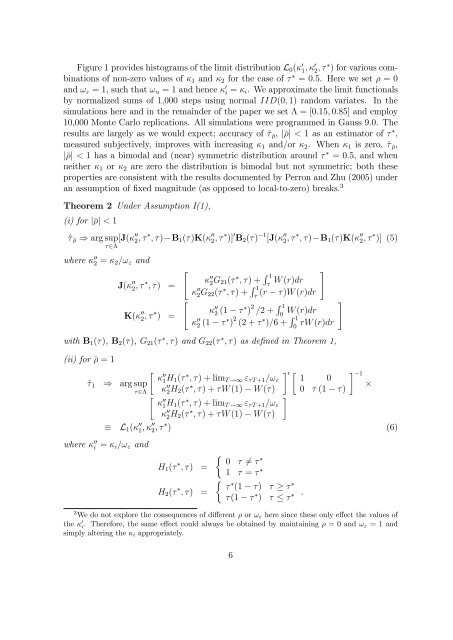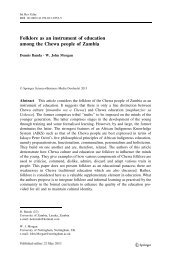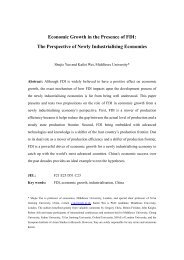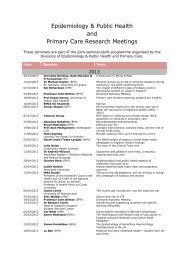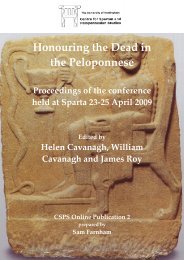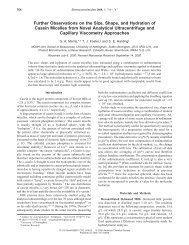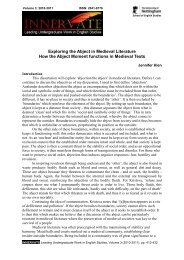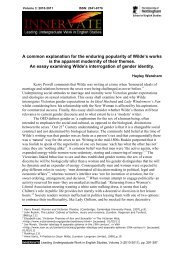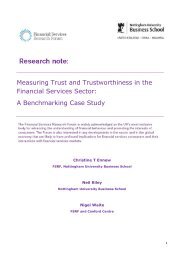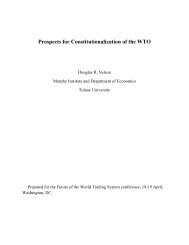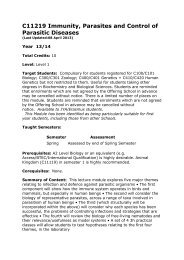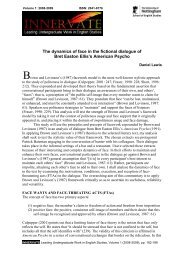Break date estimation for models with deterministic structural change
Break date estimation for models with deterministic structural change
Break date estimation for models with deterministic structural change
Create successful ePaper yourself
Turn your PDF publications into a flip-book with our unique Google optimized e-Paper software.
Figure 1 provides histograms of the limit distribution L 0 ( 0 1; 0 2; ) <strong>for</strong> various combinations<br />
of non-zero values of 1 and 2 <strong>for</strong> the case of = 0:5. Here we set = 0<br />
and ! " = 1, such that ! u = 1 and hence 0 i = i . We approximate the limit functionals<br />
by normalized sums of 1,000 steps using normal IID(0; 1) random variates. In the<br />
simulations here and in the remainder of the paper we set = [0:15; 0:85] and employ<br />
10,000 Monte Carlo replications. All simulations were programmed in Gauss 9.0. The<br />
results are largely as we would expect; accuracy of ^ , jj < 1 as an estimator of ,<br />
measured subjectively, improves <strong>with</strong> increasing 1 and/or 2 . When 1 is zero, ^ ,<br />
jj < 1 has a bimodal and (near) symmetric distribution around = 0:5, and when<br />
neither 1 or 2 are zero the distribution is bimodal but not symmetric; both these<br />
properties are consistent <strong>with</strong> the results documented by Perron and Zhu (2005) under<br />
an assumption of xed magnitude (as opposed to local-to-zero) breaks. 3<br />
Theorem 2 Under Assumption I(1),<br />
(i) <strong>for</strong> jj < 1<br />
^ ) arg sup[J( 00<br />
2; ; ) B 1 ()K( 00<br />
2; )] 0 B 2 () 1 [J( 00<br />
2; ; ) B 1 ()K( 00<br />
2; )] (5)<br />
2<br />
where 00<br />
2 = 2 =! " and<br />
J( 00<br />
2; ; ) =<br />
K( 00<br />
2; ) =<br />
"<br />
"<br />
00<br />
2G 21 ( ; ) + R #<br />
1<br />
W (r)dr<br />
<br />
2G 22 ( ; ) + R 1<br />
(r )W (r)dr <br />
00<br />
00<br />
2 (1 ) 2 =2 + R #<br />
1<br />
W (r)dr<br />
0<br />
00<br />
2 (1 ) 2 (2 + )=6 + R 1<br />
rW (r)dr 0<br />
<strong>with</strong> B 1 (), B 2 (), G 21 ( ; ) and G 22 ( ; ) as dened in Theorem 1,<br />
(ii) <strong>for</strong> = 1<br />
<br />
00<br />
^ 1 ) arg sup 1H 1 ( 0 1<br />
; ) + lim T !1 " T +1 =! " 1 0<br />
2 00<br />
2H 2 ( <br />
; ) + W (1) W () 0 (1 )<br />
<br />
<br />
00<br />
1H 1 ( ; ) + lim T !1 " T +1 =! "<br />
00<br />
2H 2 ( ; ) + W (1) W ()<br />
L 1 ( 00<br />
1; 00<br />
2; ) (6)<br />
where 00<br />
i = i =! " and<br />
H 1 ( ; ) =<br />
H 2 ( ; ) =<br />
0 6= <br />
<br />
1 = <br />
(1 ) <br />
(1 ) :<br />
3 We do not explore the consequences of dierent or ! " here since these only eect the values of<br />
the 0 i . There<strong>for</strong>e, the same eect could always be obtained by maintaining = 0 and ! " = 1 and<br />
simply altering the i appropriately.<br />
6


